Wall-hung toilet with installation: selection rules, pros and cons of such a solution + installation steps
Engineering features of plumbing fixtures are usually associated with saving space in the limited space of a bathroom or toilet. Compact equipment that retains its functionality and ease of use as much as possible is always preferable.
For example, a wall-hung toilet with installation completely frees up the floor, as it is attached to the wall structure. Thanks to this, the space expands not only visually, but also in the literal sense of the word. Let's find out whether the suspended model is so good and what conditions must be met for its installation.
The content of the article:
Features of the wall-hung type of toilet
There are many opinions about mounted models: some users find them inconvenient and unreliable, while others consider them the only acceptable ones. To find out the truth, let’s remember how a wall-hung toilet compares favorably with its floor-standing counterparts, and what its weaknesses are.
Distinctive features of the design
In total, there are two modifications of toilets when it comes to the installation method. The first category is traditional floor products, the second is suspended, mounted on a fixed structure.
A metal frame fixed with anchors on the wall and floor is called installation. The toilet bowl is attached to it.

Unlike the floor-standing model, which consists of two structural elements - the toilet itself and the adjacent cistern, the wall-mounted version has more components:
- installation, masked by a partition;
- bowl with a set of fastenings;
- flat tank, also walled up in the wall;
- button, regulating drainage and located in a convenient location.
All elements have features that are explained by the installation method:
It’s convenient that there is a choice when purchasing one or another model. You can purchase a complete toilet along with the installation.
But large companies more often implement a different scheme: they sell bowls and frames separately. This creates more decisions, it’s easier to choose the height of the seat, and decide on the design of the bowl.
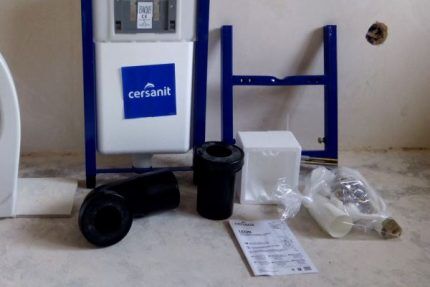
The versatility of the products is achieved by uniformity of size: the same diameter of pipes and holes, the distance between the studs. If after some time you want changes and there is a desire to change the toilet bowl, then an old, already installed installation will do.
Pros and cons of modification with installation
Users quickly appreciated the advantages of wall-hung models, and toilets with installations began to be found more and more often in city apartments and private houses. Moreover, they are installed not only in residential premises, but also in office, entertainment, public institutions, restaurants, and hotels.
Advantages of using wall-mounted toilets with built-in installation instead of traditional floor-mounted analogues:
Since the tank is masked by a partition, the noise from the movement of water is less audible.Modern models take into account the level of drain intensity, which is reflected in the design of the button (key). There are two options for water consumption: economical or full.
But there are also disadvantages that force buyers to purchase more conventional floor-standing models.
These include:
- increasing the total cost due to the purchase of an installation;
- difficult access to communications, which becomes extremely inconvenient for preventive and repair work;
- reduction in the volume of the toilet room due to the construction of an additional wall;
- installation of the structure and finishing work require skill and accuracy.
Disadvantages can be compensated for by accurate markings, skillful installation work and thoughtful design of the partition.
If you build a convenient but almost invisible inspection hatch into the false wall, access to the pipes and tank will be ensured, and the aesthetics of the interior will be maintained.
Criteria for choosing a wall-hung toilet
First of all, you need to find a kit that fully meets the installation conditions, or a separate toilet and installation that match each other in size and other characteristics.
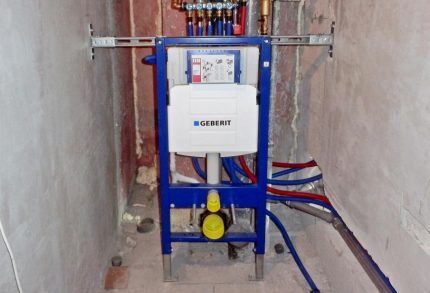
But more attention is paid to the part that comes out, that is, the toilet itself.
When choosing it, you should take into account such characteristics as:
- material of manufacture – in addition to traditional ceramics, there are products made of glass, metal, plastic, but porcelain or earthenware is preferable;
- seat dimensions – from 54 cm compact products to 70 cm special toilets for the disabled;
- form – oval is more common, but there are rare design solutions of round, rectangular or other configurations;
- bowl structure – we recommend choosing comfortable-to-use models with an anti-splash system or a gentle slope;
- color design – white is considered a classic, but today it is possible to purchase a product of any shade, and even with a pattern or design;
- flush device – a circular system is much more effective than a direct flush.
In addition to the standard set of characteristics, design features should also be taken into account - for example, a convenient lid with a microlift and a double flush button.
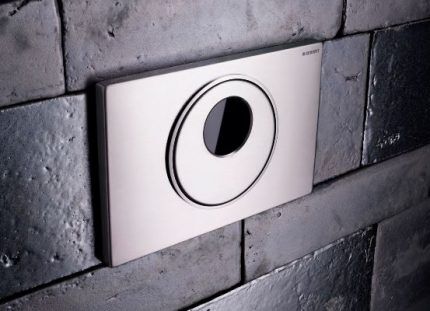
Expensive wall hung toilets They differ from budget ones not only in the material of manufacture and their relationship to a well-known brand. As a rule, they are equipped with additional functions: remote control, drying or blowing, aeration, heating. Some are a combination toilet and bidet.
When choosing a manufacturer, you should rely on the company’s respectability, user reviews, the ability to replace the bowl, and assortment. Plumbing brands are especially popular Сersanit, Roca, Geberit, Villeroy & Boch, Grohe, Jacob Delafon, Vitra, Laufen, AM.PM.
Installation instructions for the mounted model
The main installation guide is always the instructions that come with both the toilet and the frame. Usually it looks like several diagrams or drawings indicating dimensions and order of actions.
If you are not ready to decipher the schematic instructions yourself, it is better to contact experienced plumbers, since installation of frame structure, pipes and bowls, precision and skill are very important.
Stage #1 - preparatory work
Preparation includes the purchase of the necessary plumbing equipment and additional installation parts.
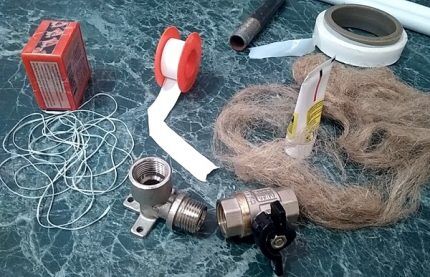
You also need to get the tool:
- hammer drill + drill 10 mm;
- grinder;
- a set of keys, including gas and adjustable;
- screwdriver;
- hammer;
- marking tool - tape measure, level, marker;
- soldering iron or press pliers - for welding of polypropylene pipeline or crimping metal-plastic pipes.
Which is better to choose: polypropylene or metal-plastic pipes Find out from our recommended article.
When everything is prepared, turn off the water and assemble the installation. Before installing the frame, some mounting elements are installed on it - brackets, adapters, pipes. We attach a fitting to the tank hose.
Stage #2 - installation installation
Before installation installations for hanging plumbing we prepare the place - we install sewer and water pipes, securely fasten them to the wall with clamps. Throughout the entire installation process, we remember that the structure will be covered with plasterboard, so we carry out all work responsibly.
There is a sticker on the frame with markings indicating the maximum installation height. We try to respect this value; we calculate from the finished floor - not from concrete, but from ceramic tiles.If it has not yet been laid, we calculate the difference.
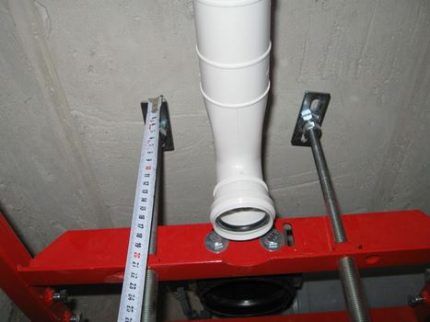
We install the frame in place, adjust the height by adjusting the legs - loosen and then tighten the adjusting bolts.
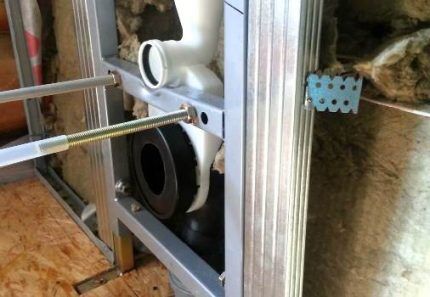
During the “trying on” we mark the attachment points, then remove the frame and drill holes in the floor with a 10 mm drill.
They are also on the wall (main), but there are different fastenings - for studs that hold the frame at a certain distance from the wall.
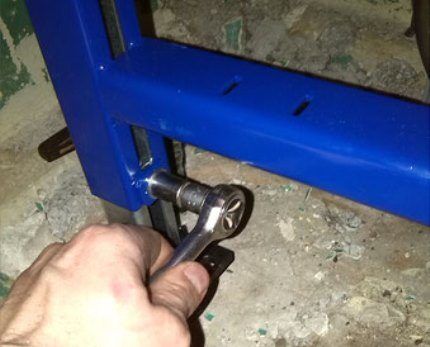
We tighten the nuts, tighten them, and connect the tank tap. In place of the button installation we install a foam template, which is removed only after the partition is erected.
We specify the distance between the mounting studs for the toilet (there are 2 options), screw them into the required holes, and put on the protective elements.
Stage #3 - fixing the bowl
If the installation is installed correctly, bowl installation won't take much time. Usually, between these two stages, a partition or box is installed to mask the installation.
We measure the distance from the pipe outlet to the toilet flares, which are located in the inner part of the bowl facing the wall.We put pipes on them and push them all the way.
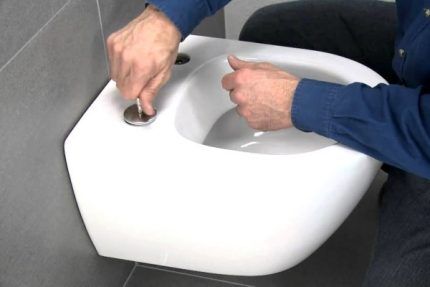
First we put on the washers, then just tighten the nuts.
Stage #4 - attaching the flush button
We remove the foam template and attach a plastic installation frame in its place. We use the screws that are included in the kit and a screwdriver or screwdriver. Then we screw in the threaded rods that will be controlled by the button, adjust their position and fix them.
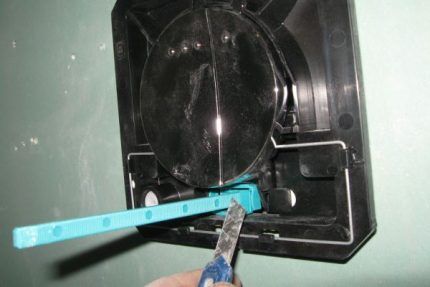
The final touch is the installation of a decorative strip with a button. Apply it to the rods and press until it clicks. Let's check how the mechanism works.
After completion of the work, we complete finishing activities. Don't forget to equip plumbing hatch for access to internal communications, otherwise at the first accident you will have to dismantle the partition.
Conclusions and useful video on the topic
Video #1. Example of installation of a suspended model:
Video #2. Instructions for mounting the bowl and installing the button:
Video #3. Installation of the installation in a box:
Installing the installation yourself is possible and acceptable, but only if you have the skills to work with concrete and know how to read the instructions correctly. The consequences of improper installation are difficult to correct - you will have to completely disassemble the structure and demolish the partition.
If there is even the slightest doubt about your own skills, it is better to invite an experienced plumber.Do not forget that the manufacturer provides a 10-year warranty only if the installation is carried out correctly and in compliance with all recommendations..
Would you like to tell us about how you installed a wall-hung toilet and installation for it in your apartment or office? Do you want to share technological nuances that will be useful to site visitors? Please write comments in the block below, post photos and ask questions about the topic of the article.




As you know, “never say never,” but I honestly can’t imagine what would have to happen for me to want to install such a miracle of design in my home. And it's not all about appearance. Externally, by the way, everything is just cool! And the floor under the toilet is free (easier to clean), and it looks original and stylish, no doubt. But, damn, these structures in the wall, these studs on which the thicket is attached - this is monstross... A friend had a business, guests came home, among the guests was a man, big and heavy. I went to the toilet. He sat on the wall-hung toilet. Fell! This installation simply breaks out of the wall. Fortunately, he escaped with bruises and contusions, but it could have killed him. It turns out that the passport for this toilet stated “up to 100 kg.” Or “up to 120”, I don’t remember exactly. But the man weighed more in any case, and the owners forgot to warn the guests about this. I'm certainly not 100 kg. And there are no such people in the family, but such stories are still scary. Well, the same guest will come to me and kill himself? Well, what the hell, such “beauty”.
This is a myth; according to standards, wall-hung toilets must hold up to 400 kg. The issue is obviously due to incorrect installation.You can also fall from a regular toilet if it is not secured correctly.
The wall-hung toilet is just another fashionable fad that has come and will go away in a short period of time. What are its advantages? Can you hear less water noise? Well, we don’t use it so often that the noise of the water starts to irritate us. Are toilet floors easier to clean? I doubt that many people have such large apartments that saving 2 minutes when cleaning the toilet plays a big role. But such toilets have a lot of disadvantages - both the price and the difficulty of repairs.
In addition to the aesthetic advantages of wall-hung toilets, it is difficult to find practical advantages when compared with models of classical installation. But for many it is very important that the bathroom has an individual design solution, and wall-hung models have a wide variety in this regard. With this installation, all communications are hidden behind a wall or partition.
You don’t have to worry too much about the fact that repair and maintenance work will require complex dismantling later. Many people now make a door on the side, through which it is easy to gain access for repairs and maintenance. It is sewn up with plaster, placed on hinges and covered with plastic or tiles so that it fits into the overall interior and does not stand out in any way.
During the renovation of a new house, a wall-hung toilet was installed. Very beautiful and modern. I can’t imagine this Soviet and wretched toilet with a leg and a cistern in my house))